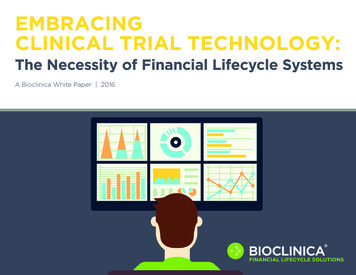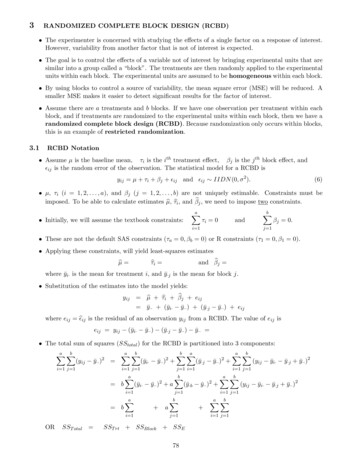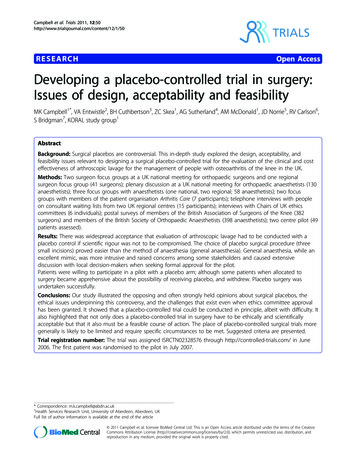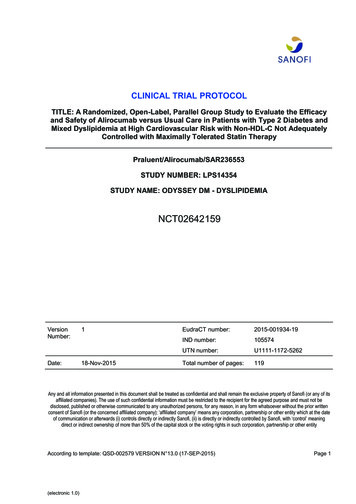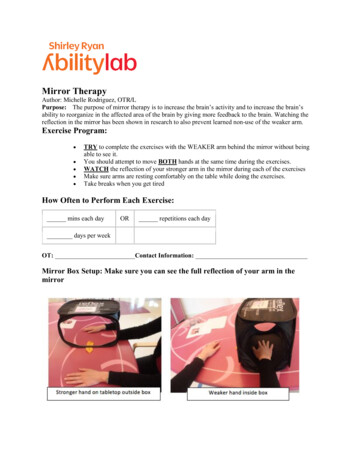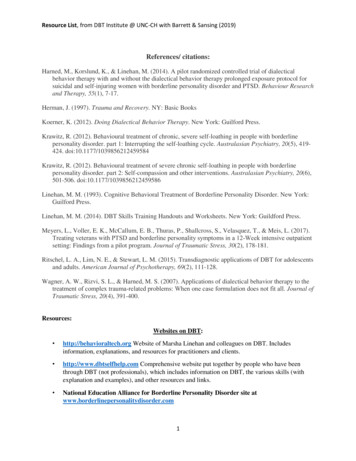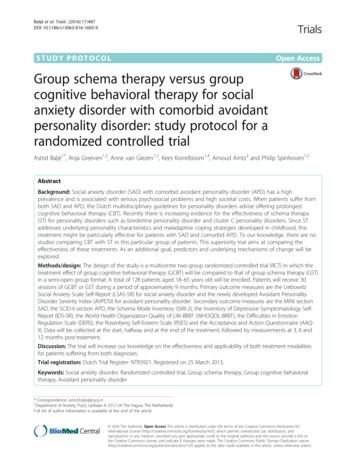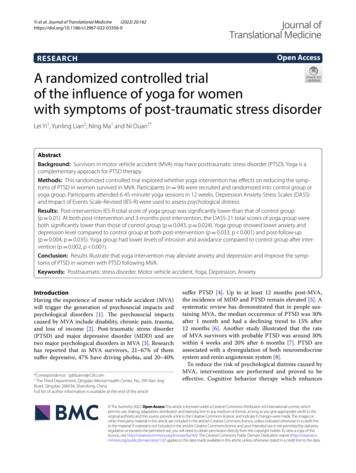
Transcription
(2022) 20:162Yi et al. Journal of Translational Journal ofTranslational MedicineOpen AccessRESEARCHA randomized controlled trialof the influence of yoga for womenwith symptoms of post‑traumatic stress disorderLei Yi1, Yunling Lian2, Ning Ma1 and Ni Duan1*AbstractBackground: Survivors in motor vehicle accident (MVA) may have posttraumatic stress disorder (PTSD). Yoga is acomplementary approach for PTSD therapy.Methods: This randomized controlled trial explored whether yoga intervention has effects on reducing the symptoms of PTSD in women survived in MVA. Participants (n 94) were recruited and randomized into control group oryoga group. Participants attended 6 45-minuite yoga sessions in 12 weeks. Depression Anxiety Stress Scales (DASS)and Impact of Events Scale-Revised (IES-R) were used to assess psychological distress.Results: Post-intervention IES-R total score of yoga group was significantly lower than that of control group(p 0.01). At both post-intervention and 3-months post intervention, the DASS-21 total scores of yoga group wereboth significantly lower than those of control group (p 0.043, p 0.024). Yoga group showed lower anxiety anddepression level compared to control group at both post-intervention (p 0.033, p 0.001) and post-follow-up(p 0.004, p 0.035). Yoga group had lower levels of intrusion and avoidance compared to control group after intervention (p 0.002, p 0.001).Conclusion: Results illustrate that yoga intervention may alleviate anxiety and depression and improve the symptoms of PTSD in women with PTSD following MVA.Keywords: Posttraumatic stress disorder, Motor vehicle accident, Yoga, Depression, AnxietyIntroductionHaving the experience of motor vehicle accident (MVA)will trigger the generation of psychosocial impacts andpsychological disorders [1]. The psychosocial impactscaused by MVA include disability, chronic pain, trauma,and loss of income [2]. Post-traumatic stress disorder(PTSD) and major depressive disorder (MDD) and aretwo major psychological disorders in MVA [3]. Researchhas reported that in MVA survivors, 21–67% of themsuffer depressive, 47% have driving phobia, and 20–40%*Correspondence: qdduanni@126.com1The Third Department, Qingdao Mental Health Center, No. 299 Nan JingRoad, Qingdao 266034, Shandong, ChinaFull list of author information is available at the end of the articlesuffer PTSD [4]. Up to at least 12 months post-MVA,the incidence of MDD and PTSD remain elevated [5]. Asystematic review has demonstrated that in people sustaining MVA, the median occurrence of PTSD was 30%after 1 month and had a declining trend to 15% after12 months [6]. Another study illustrated that the rateof MVA survivors with probable PTSD was around 30%within 4 weeks and 20% after 6 months [7]. PTSD areassociated with a dysregulation of both neuroendocrinesystem and renin angiotensin system [8].To reduce the risk of psychological distress caused byMVA, interventions are performed and proved to beeffective. Cognitive behavior therapy which enhances The Author(s) 2022. Open Access This article is licensed under a Creative Commons Attribution 4.0 International License, whichpermits use, sharing, adaptation, distribution and reproduction in any medium or format, as long as you give appropriate credit to theoriginal author(s) and the source, provide a link to the Creative Commons licence, and indicate if changes were made. The images orother third party material in this article are included in the article’s Creative Commons licence, unless indicated otherwise in a credit lineto the material. If material is not included in the article’s Creative Commons licence and your intended use is not permitted by statutoryregulation or exceeds the permitted use, you will need to obtain permission directly from the copyright holder. To view a copy of thislicence, visit http:// creat iveco mmons. org/ licen ses/ by/4. 0/. The Creative Commons Public Domain Dedication waiver (http:// creat iveco mmons. org/ publi cdoma in/ zero/1. 0/) applies to the data made available in this article, unless otherwise stated in a credit line to the data.
Yi et al. Journal of Translational Medicine(2022) 20:162the adaptive psychological, social, and behavioral skillsof survivors is effective in the improvement of psychological symptoms after MVA [9].As a non-pharmacologic strategy, yoga combines thepractice of meditation, physical postures, and breathing[10]. Recently, yoga has been utilized to reduce stressand improve psychological disorder [11]. In a number of populations, yoga is effective in reducing thePTSD symptoms [12]. It has been proved that in PTSDpatients, the performance of yoga reduces PTSDcaused physiological arousal and inhibits PTSD pathology through improving somatic regulation and bodyawareness [13].Since yoga is able to ameliorate psychological andphysical conditions of PTSD patients, this randomizedcontrolled trial aimed to evaluate the effect of yoga onreducing symptoms of PTSD in women after MVA.Fig. 1 CONSORT flow diagramPage 2 of 7MethodsParticipantsThis study was approved by the Ethics Committee ofQingdao Mental Health Center. Eligible participants wereadult women diagnosed with MVA-related PTSD thathappened at least 3 months ago. PTSD was diagnosedby meeting Diagnostic and Statistical Manual of MentalDisorders 4th Edition (DSM-IV) PTSD criterion A1 fora traumatic event. The exclusion criteria were: (1) Havingorganic mental disorder, symptomatic bipolar disorder,psychotic disorder, or schizophrenia; (2) Having brainsurgery history, brain damage, or neurological problems;(3) Having substance abuse or currently suicidal.ProceduresFigure 1 showed the flow for recruitment, intervention,and assessment processes. A total of 165 individuals
Yi et al. Journal of Translational Medicine(2022) 20:162Page 3 of 7were assessed for eligibility, of whom 94 were includedin this trail. After completing baseline measures, these 94patients were randomly divided into yoga group (n 47)and control group (n 47) through a web-based randomization system. Participants in yoga group attended6 45-minuite yoga sessions in 12 weeks. In the controlgroup, yoga sessions were replaced by exchanging dailylife experiences and playing board games in 12 weeks.After intervention and 3-month follow-up, participantsin both groups were assessed. For the 47 participants inyoga group, 3 lost contact, 7 withdrew, and 37 completed.39 participants in control group completed this trail after8 participants withdrew.InterventionParticipants in yoga group were provided 12-week yogasessions developed by the research team, 1 session inevery 2 weeks. Yoga sessions were held in a specific meeting room and performed under the instruction of a yogainstructor. The style of yoga in this trail was Kripalu. Thiskind of yoga focuses on compassionate self‐observation,building connections between mind and body on the present moment. The yoga sessions were designed to adaptfor all body types and be noncompetitive. The contents ofyoga sessions were shown in Table 1.ranges from 0 to 88. Higher IES-R score indicates worsesymptom.DASS-21 was employed to assess the severity of psychological distress. This self-report scale has 21 items toevaluate anxiety, depression, and stress. The score of eachitem is from 0 to 3 and the sum of the scores of itemsis total score. Higher score shows stronger symptom ofanxiety, depression, and stress.Data analysisIn this research, statistical analyses were performedby SPSS version 17.0 software. Data were presented asmean standard deviation (SD) or proportion (%). Differences in continuous variables between different groupswere compared by ANOVA test. *p 0.05, **p 0.01,***p 0.001, ns: no significance.ResultsDemographicsTable 2 showed the participants’ characteristics in twogroups. Based on the result of statistical analysis, no significant differences were found between the participantsin two groups on any of the characteristics, such as age,body mass index (BMI), education level, marital status,employment status, role in MVA, injury severity, dayssince MVA, or perceived life threat to self (all p 0.05).AssessmentsTotal scores of IES‑R and DASS‑21In this trail, psychometric assessments included theImpact of Events Scale-Revised (IES-R) and the Depression, Anxiety and Stress Scale (DASS-21). All the measures were collected at baseline, post-intervention, and3-month follow-up.IES-R was employed to evaluate PTSD symptoms.This self-report measure consists of 22 items. The scoreof each item is from 0 to 4 (0 not at all, 1 a little bit,2 moderately, 3 quite a bit, 4 extremely). There arethree subscales, avoidance, intrusion, and hyperarousal.The total score is the sum of the three subscales scores,IES-R total scores of participants in these two groupswere shown in Fig. 2. In both groups, IES-R total scoresdecreased throughout the trial. No significant differenceswere found between two groups on IES-R total scores atbaseline and post-follow-up (all p 0.05). However, postintervention IES-R total score of yoga group was significantly lower than that of control group (p 0.01).DASS-21 total scores were shown in Fig. 3. DASS21 total scores showed reductions over time for bothgroups. At baseline, the DASS-21 total scores in bothgroups had no significant difference (p 0.05). At bothTable 1 Contents of yoga sessionsTime (min)ContentLesson 145Notice the breath coming into your body and leaving your body. Notice how you feelLesson 245Focus on how you feel in a yoga pose: how do your legs and feet feel? What do yourarms and hands feel? What emotions are you experiencing?Lesson 345Pay attention to what the body feels in a yoga pose instead of how you lookLesson 445Challenge yourself to stay in a pose longer, even if it is slightly uncomfortable, andpractice to tolerate the discomfort. Learn to notice the emotions and accept situations for the way they areLesson 545Relax yourself and release your stress. Create the experience that allows you to let goLesson 645Image putting bad emotions aside when you start your yoga practice
Yi et al. Journal of Translational Medicine(2022) 20:162Page 4 of 7Table 2 Comparison of participant characteristics between yogaand control groupsYoga group (n 37) Controlgroup(n 39)p valueAge (years)40.8 (13.2)42.1 (15.9)0.699BMI (kg/m2)28.4 (5.0)27.2 (4.4)0.271EducationHigh school or lower20 (54.1)28 (71.8)University or higher17 (45.9)11 (28.2)0.109Marital statusSingle8 (21.6)6 (15.4)23 (62.2)22 (56.4)6 (16.2)11 (28.2)Full time18 (48.6)21 (53.8)Part time8 (21.6)6 (15.4)Married/in a relationshipDivorced/widowed0.422Employment statusUnemployed6 (16.2)8 (20.5)Retired3 (8.1)4 (10.3)Student2 (5.4)0 (0.0)21 (56.8)19 (48.7)7 (18.9)9 (23.1)0.576Fig. 2 IES-R total scores for the two groups by time point. Data wereshown as mean SD. *p 0.05 compared with control group. IES-Rimpact of event scale-revisedRole in MVADriverPassengerMotorbike rider5 (13.5)7 (17.9)Cyclist3 (8.1)2 (5.1)Pedestrian1 (2.7)0.8842 (5.1)Injury severity1.37(1.02)1.30 (0.95)0.758Days since MVA56.3 (18.4)63.8 (20.1)0.094Perceived life threatto self3.07 (1.10)3.25 (1.04)0.466BMI body mass index, MVA motor vehicle accidentData are shown as mean (SD) or n (%)post-intervention and 3-months post intervention, theDASS-21 total scores of yoga group were both significantly lower than those of control group (p 0.043,p 0.024).Fig. 3 DASS total scores for the two groups by time point. Data wereshown as mean SD. *p 0.05 compared with control group. DASSdepression, anxiety, and stress scaleThe scores of subscales in DASS‑21 and IES‑RThe scores of subscales in DASS-21 and IES-R werepresented in Table 3. No significant differences werefound between groups for baseline IES-R and DASS21 subscales. For DASS-21, however, the level of stresswas not influenced by the intervention of yoga. For IESR, participants in yoga group had lower levels of intrusion and avoidance compared to control group afterintervention (p 0.002, p 0.001). At 3-months postintervention, intrusion level and avoidance level in theyoga group were significantly lower than in the controlgroup (p 0.037).DiscussionThis randomized controlled trail examined a 12-weekyoga intervention’s effect on psychological distress inwomen with PTSD following MVA. The preliminaryresults demonstrated that both yoga group and controlgroup showed trends for the improvement of psychological distress, while the intervention of yoga promotedthe recovery of psychological disorders in women withPTSD following MVA. There were significant reductions in depression, anxiety, and intrusion in yoga group
Yi et al. Journal of Translational Medicine(2022) 20:162Page 5 of 7Table 3 IES-R and DASS for control and yoga groups at baseline and post interventionYoga group (n 37)Control group (n 39)p valueDepression14.3 (5.1)14.8 (4.7)0.659Anxiety12.2 (3.5)13.3 (4.1)0.212Stress20.0 (8.6)19.1 (7.7)0.633Total46.5 (15.6)47.2 (16.2)0.848Depression11.6 (3.4)13.5 (4.2)0.0339.1 (2.9)11.9 (3.3) 0.001Stress15.4 (6.4)16.7 (7.8)0.429Total36.1 (11.2)42.1 (14.1)0.043Depression10.5 (2.9)12.8 (3.8)0.0048.8 (3.0)10.3 (3.1)0.035Stress14.8 (5.2)15.9 (4.6)0.333Total34.1 (9.9)39.0 (8.5)0.024Intrusion16.3 (7.2)15.6 (7.7)0.683Avoidance15.1 (6.5)13.8 (5.9)0.365Hyperarousal10.1 (5.7)9.8 (4.8)0.805Total41.5 (19.5)39.2 (17.2)0.588Intrusion10.4 (5.1)14.5 (6.0)0.0029.2 (3.9)12.6 (4.4) 0.001DASSBaselinePost interventionAnxiety3 months post interventionAnxietyIES-RBaselinePost interventionAvoidanceHyperarousal8.1 (3.2)9.4 (4.8)0.16727.7 (12.8)36.5 (16.1)0.010Intrusion9.4 (4.2)11.5 (4.4)0.037Avoidance9.2 (3.9)10.9 (3.5)0.005Hyperarousal7.6 (3.1)8.6 (2.8)0.14526.2 (12.0)31.0 (10.5)0.068Total3 months post interventionTotalDASS, Depression, anxiety, and stress scale; IES-R, Impact of Event Scale – RevisedData are shown as mean (SD)as compared to control group after 12-week interventionand 3-month follow-up. Additionally, the intervention ofyoga had no notable influence on stress and hyperarousalin women with PTSD following MVA.PTSD refers to a series of clinical symptoms shown bythe patient’s psychological and physical excessive stressresponse after personally experiencing a serious traumatic event that causes or may lead to death or physical injury [14]. With the deepening of research, PTSD iswidely present in people who have experienced all serioustraumas including violent events and natural disasters[15]. In modern society, more attention has been paidto the psychological disorder caused by traffic accidents,including PTSD. It has been reported that the incidenceof MVA-caused PTSD ranges from 8.5% to 23.1% [16].However, in China, the patients’ physiological problemscaused by traffic accidents have been effectively treated,while the psychological problems such as PTSD havenot received enough attention and corresponding treatment, which often increases the patient’s suffering andprolongs the treatment. PTSD has association with bothdysregulation of neuroendocrine system and renin–angiotensin–aldosterone-system. Traumatization has lastingand cumulative effects on the activity of renin–angiotensin–aldosterone-system and elevated renin levels mayincrease the risk for developing PTSD and other disease[8, 17].In recent years, yoga has been considered as complementary and alternative medicine [18]. Yoga is a combination of breathing techniques, meditation, physicalpostures, and relaxation which have benefits for bothphysical and mental conditions. Yoga in the school setting is a viable and potentially efficacious strategy forimproving child and adolescent health [19].Meditation and yoga are promising complementaryapproaches in the treatment of PTSD among adults[20]. A study has demonstrated the preliminary efficacyand feasibility of online yoga on alleviating symptomsof PTSD, anxiety, and depression in women who haveexperienced stillbirth [10]. A randomized controlled
Yi et al. Journal of Translational Medicine(2022) 20:162trial in women with PTSD has proved that Kripalubased yoga intervention reduces expressive suppressionand improves PTSD symptoms through increasing psychological flexibility [21]. Another research also showedthat a 12-session Kripalu-based yoga intervention playsa role in the alleviation of reexperiencing and hyperarousal symptoms in women with PTSD [21]. Yoga maybe an effective alternative to trauma-focused therapy forwomen veterans with PTSD [22]. Researchers have illustrated that yoga practice has association with decreasedsympathetic activity, increased parasympathetic activity, and down-regulated hypothalamic–pituitary–adrenal axis and positive effects on cognitive activity [23,24]. Practicing yoga triggers the adjustment of cognitionand behavior through enhancing mind–body awareness,increases behavioral activation in pleasant activities,improves emotion‐regulation skill, and reduces reexperiencing and avoidance symptoms [25–27]. Yoga has positively impact on PTSD symptoms and may be an effectiveadjunctive treatment for PTSD. Thus, in this research, weexplored whether Kripalu-based yoga intervention contributed to the improvement of psychological distress inwomen with PTSD following MVA.In this trail, participants in yoga group were provided12-week Kripalu-based yoga sessions. Sessions were heldonce every 2 weeks. Kripalu-based yoga emphasizes theconnections between mind and body. Kripalu yoga isoften described as "dynamic meditation", focusing lesson the physical details of the yoga postures and more onthe emotional and psychological feelings they bring tothe person, thus requiring the student to maintain a gentle, compassionate and introspective attitude. This kindof yoga believes that the body has its own wisdom andsends out messages to prompt the individual to practicethe yoga postures in a fluid and natural way. Each yogapose is held for a long period of time in order to uncoveror release repressed emotions. Kripalu yoga may havepotential as a PTSD therapy in a veteran or military population [28].In 47 participants of yoga group, only 6 dropped outduring 12-week intervention. Thus, most of participants were satisfied with the intervention. Time, mood,and stress might be the major reason for not completing the study. When examined separately for the twogroups, the IES-R total scores and DASS-21 total scoresboth decreased for both groups after 12-week intervention and 3-month follow-up. IES-R total scores in yogagroup was significantly lower than in control grouppostintervention. DASS-21 total scores also had significant differences between groups postintervention andpost-follow-up. Thus, the 12-week intervention of yogaenhanced the improvement of psychological distress inwomen with PTSD following MVA. Decreased scoresPage 6 of 7of IES-R and DASS-21 indicated that clinical improvement in the PTSD symptoms of women also happenedin control group. It was possible that the exchanging ofdaily life experiences and playing board games enhancedthe communication between patients and contributedto the improvement of psychological distress. Alternatively, other unmeasured variables may also account forthe improvement in control group. When compared withcontrol group, there were significant reduction in anxietyand depression symptoms at post-intervention and follow-up, but not in stress. The intervention of yoga mighthave no significant effect on alleviating stress caused byPTSD in woman survived from MVA. Results also demonstrated the short-term effects of yoga on intrusion andavoidance symptoms and the long-term effect on intrusion in women with PTSD following MVA. These findings provided preliminary evidence to suggest that yogamay reduce psychological distress and improve PTSDsymptoms among women with PTSD following MVA.Several limitations of the research should be noted.First, the limitation of time and funding caused a relatively small sample size. Limited sample size mightinfluence the detection of differences both between andwithin groups and limit the generalizability of conclusion. Second, we only evaluated the influence of the Kripalu-based yoga intervention on the participants. Sincemany different styles of yoga exist, different types mighthave diverse effects on physical and mental health andPTSD symptom reduction. Kripalu-based yoga mightnot be the most beneficial type. Although Kripalu-basedyoga reduced psychological distress and improve PTSDsymptoms, which specific aspect of the yoga practice inthis trail was most effective was not evaluated. Third,in this trail, we utilized self-report data. Data might beinfluenced by the expectancy effects of patients and theresults were subject to biases that are inevitable with thistype of data.ConclusionIn conclusion, the intervention of a 12-week yoga practice may be an effective and feasible strategy to reducepsychological distress in women with PTSD followingMVA. The results of this study suggest that alleviatingPTSD after a car accident through yoga is very feasibleand can be sustained in daily life. PTSD from car accidents remains a noteworthy social problem that requireseffective and feasible programs to alleviate PTSD inorder to prevent negative health effects. The results ofthis study support the use of Kripalu yoga to improve themental health of women with PTSD who have experienced a major car accident.AcknowledgementsNone.
Yi et al. Journal of Translational Medicine(2022) 20:162Authors’ contributionsData curation, analysis: LY, YL, NM, ND; Drafting of the manuscript: LY and ND;Concept, design of the study: LY and ND. All authors read and approved thepublication the manuscript.Page 7 of 711.FundingNone.12.Availability of data and materialsAll data generated or analyzed during this study are included in this publishedarticle.13.14.DeclarationsEthics approval and consent to participateThis study was approved by the Ethics Committee of Qingdao Mental HealthCenter.Consent for publicationAll of the authors have consented to publication of this research.15.16.17.Competing interestsThe authors declare that they have no competing interests.Author details1The Third Department, Qingdao Mental Health Center, No. 299 Nan JingRoad, Qingdao 266034, Shandong, China. 2 Department of Geriatrics, QingdaoMental Health Center, No. 299 Nan Jing Road, Qingdao 266034, Shandong,China.18.19.20.Received: 7 February 2022 Accepted: 22 March 202221.References1. Nickerson A, Aderka IM, Bryant RA, Hofmann SG. The role of attributionof trauma responsibility in posttraumatic stress disorder following motorvehicle accidents. Depress Anxiety. 2013;30:483–8.2. Craig A, Tran Y, Guest R, Gopinath B, Jagnoor J, Bryant RA, Collie A, TateR, Kenardy J, Middleton JW, Cameron I. Psychological impact of injuriessustained in motor vehicle crashes: systematic review and meta-analysis.BMJ Open. 2016;6:e011993.3. Guest R, Tran Y, Gopinath B, Cameron ID, Craig A. Psychological distressfollowing a motor vehicle crash: a systematic review of preventativeinterventions. Injury. 2016;47:2415–23.4. Mayou R, Bryant B. Consequences of road traffic accidents for differenttypes of road user. Injury. 2003;34:197–202.5. Papadakaki M, Ferraro OE, Orsi C, Otte D, Tzamalouka G, von-der-GeestM, Lajunen T, Ozkan T, Morandi A, Sarris M, et al. Psychological distressand physical disability in patients sustaining severe injuries in road trafficcrashes: results from a one-year cohort study from three European countries. Injury. 2017;48:297–306.6. Heron-Delaney M, Kenardy J, Charlton E, Matsuoka Y. A systematic reviewof predictors of posttraumatic stress disorder (PTSD) for adult road trafficcrash survivors. Injury. 2013;44:1413–22.7. Craig A, Elbers NA, Jagnoor J, Gopinath B, Kifley A, Dinh M, Pozzato I, IversRQ, Nicholas M, Cameron ID. The psychological impact of traffic injuriessustained in a road crash by bicyclists: a prospective study. Traffic Inj Prev.2017;18:273–80.8. Terock J, Hannemann A, Janowitz D, Freyberger HJ, Felix SB, Dorr M,Nauck M, Volzke H, Grabe HJ. Associations of trauma exposure andpost-traumatic stress disorder with the activity of the renin–angiotensin–aldosterone-system in the general population. Psychol Med.2019;49:843–51.9. Wu KK, Li FW, Cho VW. A randomized controlled trial of the effectivenessof brief-CBT for patients with symptoms of posttraumatic stress followinga motor vehicle crash. Behav Cogn Psychother. 2014;42:31–47.10. Huberty J, Sullivan M, Green J, Kurka J, Leiferman J, Gold K, CacciatoreJ. Online yoga to reduce post traumatic stress in women who have22.23.24.25.26.27.28.experienced stillbirth: a randomized control feasibility trial. BMC Complement Med Ther. 2020;20:173.Nolan CR. Bending without breaking: a narrative review of traumasensitive yoga for women with PTSD. Complement Ther Clin Pract.2016;24:32–40.Macy RJ, Jones E, Graham LM, Roach L. Yoga for trauma and relatedmental health problems: a meta-review with clinical and service recommendations. Trauma Violence Abuse. 2018;19:35–57.van der Kolk BA, Stone L, West J, Rhodes A, Emerson D, Suvak M, Spinazzola J. Yoga as an adjunctive treatment for posttraumatic stress disorder:a randomized controlled trial. J Clin Psychiatry. 2014;75:e559-565.Qi W, Gevonden M, Shalev A. Prevention of post-traumatic stress disorderafter trauma: current evidence and future directions. Curr Psychiatry Rep.2016;18:20.Farooqui M, Quadri SA, Suriya SS, Khan MA, Ovais M, Sohail Z, Shoaib S,Tohid H, Hassan M. Posttraumatic stress disorder: a serious post-earthquake complication. Trends Psychiatry Psychother. 2017;39:135–43.Wang X, Lan C, Chen J, Wang W, Zhang H, Li L. Creative arts program asan intervention for PTSD: a randomized clinical trial with motor vehicleaccident survivors. Int J Clin Exp Med. 2015;8:13585–91.Ahmadian E, Pennefather PS, Eftekhari A, Heidari R, Eghbal MA. Role ofrenin–angiotensin system in liver diseases: an outline on the potentialtherapeutic points of intervention. Expert Rev Gastroenterol Hepatol.2016;10:1279–88.Mohammad A, Thakur P, Kumar R, Kaur S, Saini RV, Saini AK. Biologicalmarkers for the effects of yoga as a complementary and alternativemedicine. J Complement Integr Med. 2019;16.Khalsa SB, Butzer B. Yoga in school settings: a research review. Ann N YAcad Sci. 2016;1373:45–55.Gallegos AM, Crean HF, Pigeon WR, Heffner KL. Meditation and yoga forposttraumatic stress disorder: a meta-analytic review of randomizedcontrolled trials. Clin Psychol Rev. 2017;58:115–24.Mitchell KS, Dick AM, DiMartino DM, Smith BN, Niles B, Koenen KC, StreetA. A pilot study of a randomized controlled trial of yoga as an intervention for PTSD symptoms in women. J Trauma Stress. 2014;27:121–8.Kelly U, Haywood T, Segell E, Higgins M. Trauma-sensitive yoga for posttraumatic stress disorder in women veterans who experienced militarysexual trauma: interim results from a randomized controlled trial. J AlternComplement Med. 2021;27:S45–59.Rocha KK, Ribeiro AM, Rocha KC, Sousa MB, Albuquerque FS, Ribeiro S,Silva RH. Improvement in physiological and psychological parametersafter 6 months of yoga practice. Conscious Cogn. 2012;21:843–50.Ross A, Thomas S. The health benefits of yoga and exercise: a review ofcomparison studies. J Altern Complement Med. 2010;16:3–12.Khalsa SB. Yoga as a therapeutic intervention: a bibliometric analysis ofpublished research studies. Indian J Physiol Pharmacol. 2004;48:269–85.Uebelacker LA, Tremont G, Epstein-Lubow G, Gaudiano BA, GilletteT, Kalibatseva Z, Miller IW. Open trial of Vinyasa yoga for persistentlydepressed individuals: evidence of feasibility and acceptability. BehavModif. 2010;34:247–64.Holzel BK, Carmody J, Vangel M, Congleton C, Yerramsetti SM, Gard T,Lazar SW. Mindfulness practice leads to increases in regional brain graymatter density. Psychiatry Res. 2011;191:36–43.Reinhardt KM, Noggle Taylor JJ, Johnston J, Zameer A, Cheema S, KhalsaSBS. Kripalu yoga for military veterans with PTSD: a randomized trial. JClin Psychol. 2018;74:93–108.Publisher’s NoteSpringer Nature remains neutral with regard to jurisdictional claims in published maps and institutional affiliations.
Participants in yoga group were provided 12-week yoga sessions developed by the research team, 1 session in every 2 weeks. Yoga sessions were held in a specic meet - ing room and performed under the instruction of a yoga instructor. e style of yoga in this trail was Kripalu. is kind of yoga focuses on compassionate self‐observation,

